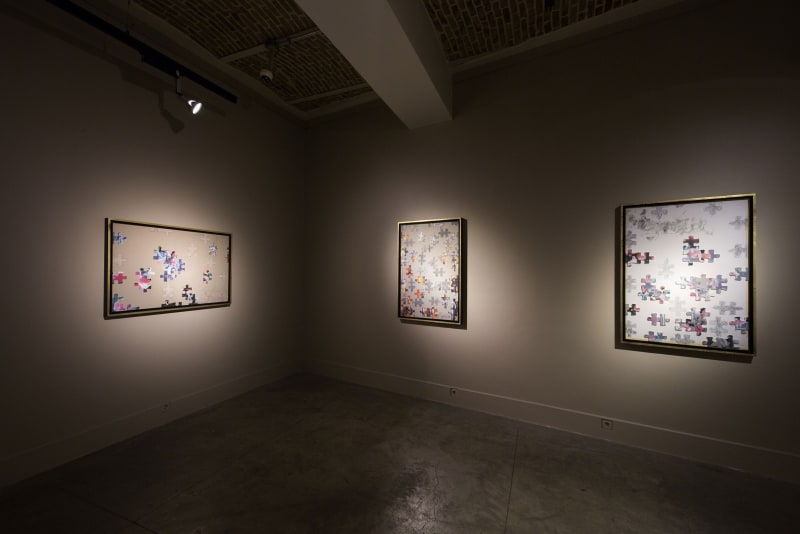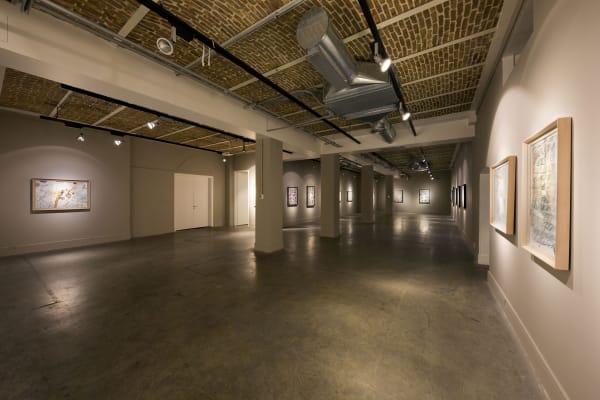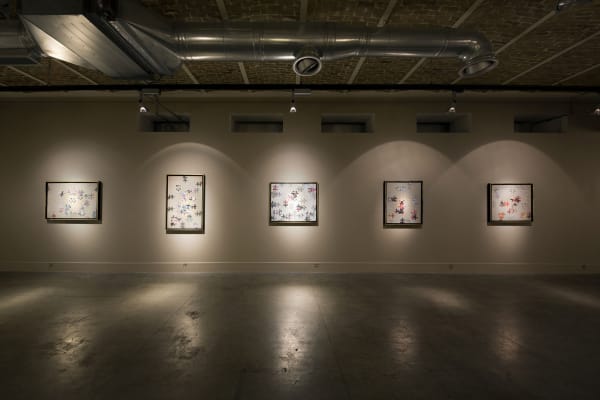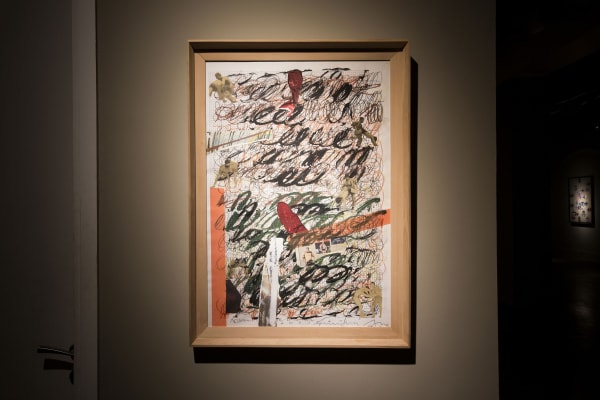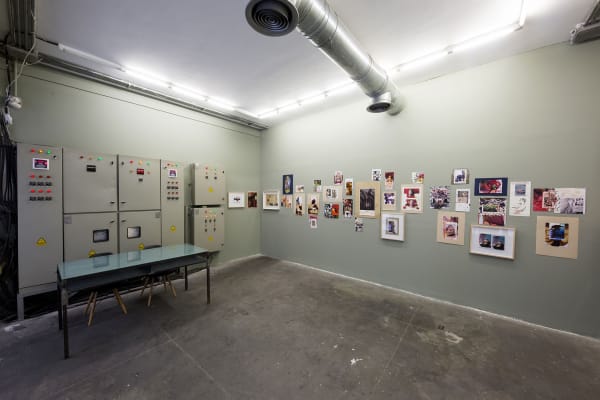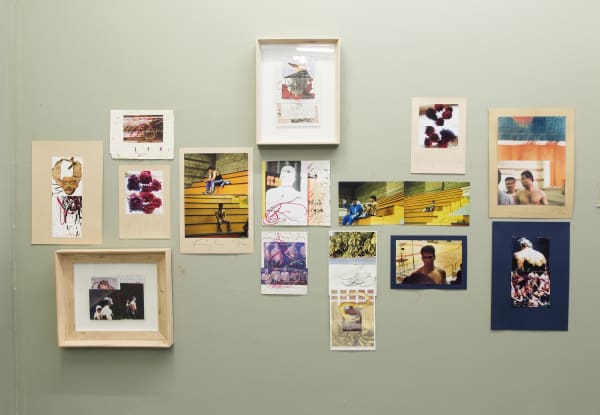Fereydoun Ave | "Rostam 2019": Dastan:Outside | V-Gallery
An Exhibition of Works from Fereydoun Ave's "Rostam in Dense Pollution" and "The Rostam Puzzle" at V-Gallery
Dastan is pleased to announce Fereydoun Ave’s latest exhibition from his Rostam series of works. The exhibition, which includes works from the artist’s “Rostam in Dense Pollution” and “The Rostam Puzzle” will be on display at V-Gallery (Dastan:Outside Projects) from April 5 to April 19, 2019.
Regarding “The Rostam Puzzle”, the artist writes: “When I first made the original collages for ‘Rostam in Late Summer’ (1999), I revisited them many times and many ways later. One of these ways was to make them into a game —a puzzle. I choose three images and printed them digitally on foam boards and cut them into a jigsaw puzzle. In 2018, when I was working with the autumnal energy, I rediscovered and recycled them into this series of works. Archetypal heroes tend to be one-dimensional but in fact they, like everyone else, are puzzles but don't fit together easily.
Fereydoun Ave continues on “Rostam in Dense Pollution”: “These are also a recycled series that took three years to come together —mixed media and collage and silk screen prints. Pollution is a general but dense and ever-worsening concept; these works are atmospheric pieces.”
Fereydoun Ave (b. 1945, Tehran, Iran) is one of the most influential individuals in Iranian contemporary art and his prolific efforts have taken diverse aspects. He received his BA in Applied Arts for Theatre from Arizona State University, studied film at New York University, and studied at the University of Seven Seas (aka Semester at Sea). During his career, which spans over five decades, he has successfully taken many different roles including artist, designer, art director, collector, curator, gallerist and art patron. His artworks have been featured in many solo exhibitions along with hundreds of group shows in galleries and museums all around the world. As well as being purchased by many notable private collectors, Ave’s work has been acquired by prestigious art institutions including The British Museum in London, The Metropolitan Museum of Art in New York, Los Angles County Museum of Art (LACMA), Centre Georges Pompidou in Paris, Cy Twombly Foundation and Tehran Museum of Contemporary Art (TMOCA).
Confusion Is Pollution
Sohrab Mahdavi
What Chogyam Trungpa said about confusion – that it provides a familiar ground to take shelter from the open, unobstructed, ever-changing, and brilliant nature of reality – can be extended to pollution. Pollution paints over contrast and difference to give us a seemingly unified visual field. Let me give you an example. For years, Starbucks has been roasting its coffee beans to near charcoal. Why? Because then every cup of Starbucks coffee would taste the same no matter where it beans came from and no matter where you have the brew. This is the bittersweet signature of Starbucks coffee. You may not like the flavor, but it has an indiscriminately familiar taste. Confusion and pollution function in the same way. They are familiar and you can rely on them to provide you with an even field that brings dullness to the senses but that shield you from the infinitude, richness, and shifty nature of appearance and experience.
For years, Fereydoun Ave has been taking his heroes to places to see what an timeless, archetypal being would do under everyday, temporal conditions. Between 1998 and 2000 his Rostams appeared "in late summer," surrounded by flowers, and starting in 2009 "in the dead of winter," with vultures hovering over head. When asked by Art Asia Pacific in 2009, "After winter will there be spring?" Ave answered almost prophetically, "That will depend on the gods of rejuvenation, but I can tell you that this is part of a much larger series." Now, in 2019, in spring, Rostam is in dense pollution and trying to juggle pieces of a puzzle that don't fit together.
Let me offer a simplified take on pollution at the expense of ignoring its other, more obvious manifestations: "Pollution is the outcome of escaping what we deem inconvenient." We have pollution because we can't take the heat of summer and the cold of winter. I chose the seasons here because I want to speak about this particular series, but any escape from the immediate situation brings pollution (and confusion). The more we try to keep the good stuff and do away with the bad, the more we run away from the abrasive parts of life, the more we pollute. I am not sure if I need to explain further. So, I will leave it here. Pollution is all- and extra-seasonal. It diffracts energy physically and attention mentally. It diffuses light to give us a hazy picture of our lived experience.
In Rostam in Dense Pollution, Ave is using the same techniques of collage, calligraphy, scribbles, lines, and paint splashes on paper that he used in his previous hero series to give them a pasture. There is nothing "dense" about his pollution. The art of Ave is in refraining from a propensity to say too much. Lines and paste-ups clutter the surface of the paper but they are scattered across the page, leaving large swaths unattended, providing a space where imagination can take wing. As viewers, we find nothing in these markings or in the empty spaces to guide us. We are on our own; free to interpret what the artist means by "pollution." In fact, if it weren't for the name "pollution," we wouldn't have thought of it. Could it be, then, that the meaning of this series is incidental? I will return to the importance of title names in the works of Ave.
In Rostam Puzzle, the artist is using a new technique (jet ink print on recycled board). We have the same figures appearing within the frame, but this time in cutout forms. Here too, we have plenty of unattended spaces, be that between puzzle pieces or in the hollow of their jigsaw cutouts. And here too, we have a hard time deciding what the puzzle is. In fact, the field within the frame is pleasantly orderly and if it weren't for the name "puzzle," we would see no hint of disorder. Puzzle pieces are cutout in the same shape, size, and form. Some are filled only with crosshatches and no pictures. In others, we can make out wrestlers and flowers that appeared in the late summer series.
There is a way to approach the works of Ave in general. The first thing that I encounter when standing before his frames is to try to find a logical connection between its title and its content. After a while, however, I realize that this relationship should be seen as a question and not as a statement. Ave has mentioned that he wants to see what his primordial understanding of heroism would do under immediate conditions. The frame is a sandbox within which he can playfully explore his own relationship with the experience of being in the present. The work itself becomes a meditative space that allows him to tap into his sub- or un-conscious, a laboratory where he experiments with different materials to manifest his proclivities, predicaments, thoughts, and emotions. In one sense, the work is a viciously personal journey. In another, it is an invitation to exhaust all logical or philosophical understanding of our current predicament, to cut the roots of patterned thoughts, and to rest in the space opened up by the work. Looking, then, involves the three steps of exhausting experience, cutting the root, and resting in seeing. We will find no answer to the question posed by the work and we don't need to make any efforts in that direction.
Pollution and confusion are two interconnected characteristics of our age. As human beings, we have striven to create a world free of complications and inconveniences. All our efforts have gone to avoiding the undesirable and to appropriating the desirable. We have only managed to heighten our confusion and to bring pollution to our lives. This is the dilemma that our inner heroes need to wrestle with today, at this juncture in our natural and cultural history. And this is what Ave is doing in search for gods of rejuvenation.
April 4, 2019
